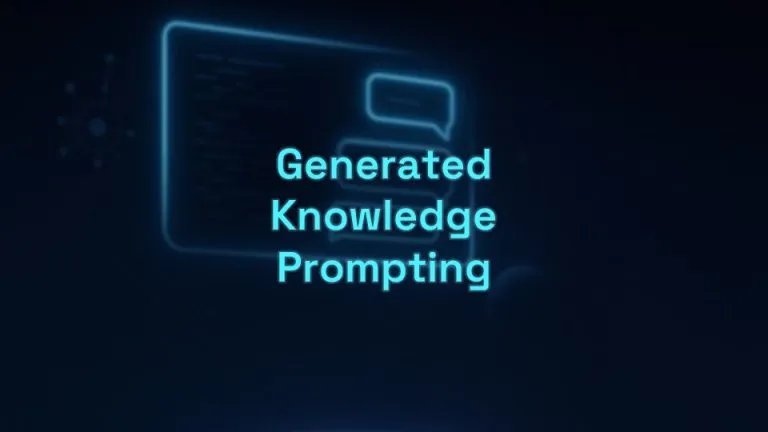Generated Knowledge Prompting: Let AI Build Knowledge Step by Step

Want deeper and more well-founded answers? The Generated Knowledge Prompting technique instructs the AI to create or gather relevant knowledge about a topic before answering a question or performing a task. This enriches responses, especially on complex or less familiar topics.
If you’re an end user who uses AI for research, learning, content creation, or problem-solving, understanding this approach will enhance your control over the quality and depth of the answers.
This article was created to help end users understand the core concepts, make technical concepts more accessible, and intentionally and explicitly adapt and apply the Generated Knowledge Prompting technique in their daily use of AI, without automatically relying on the model’s capabilities. For further technical exploration, see Learn More.
Table of Contents
What Is the Generated Knowledge Prompting Technique?
Generated Knowledge Prompting is a prompt engineering technique that asks the AI to generate or organize relevant knowledge about a topic before answering a question or completing a task. Instead of responding immediately, the AI first “thinks” about the subject by gathering facts, concepts, or internal ideas, and uses this knowledge to build a more complete response. For example, to explain “how nuclear energy works,” the AI might first be instructed to list key facts about the process before drafting the explanation.
Although Generated Knowledge Prompting is optimized when AI models internally generate knowledge from their training data, end users can simulate this technique by asking the AI to build and organize relevant information before responding, as explored in this article.
The benefits include more detailed responses, greater accuracy on complex topics, and the ability to explore less familiar areas. It’s an accessible technique that empowers users at all levels to obtain robust answers, especially in educational or analytical contexts.
Origin of Generated Knowledge Prompting
Generated Knowledge Prompting emerged from recent studies on improving response quality in language models, gaining prominence in 2022 through research that explored how internal knowledge generation enhances answer quality.
How Does It Work?
Here’s how to apply Generated Knowledge Prompting in practice:
- Ask the AI to generate relevant information about the topic.
- Then, based on this knowledge, pose the main question or task.
When to Use It?
Generated Knowledge Prompting is ideal for situations that require detailed answers, clarity on complex topics, or exploration of unfamiliar areas. Use it when you want to:
- Deepen understanding: Perfect for learning technical, scientific, or abstract concepts.
- Improve accuracy: Great for complex or ambiguous questions.
- Explore new topics: Ideal for gaining insights in areas outside your expertise.
Practical Examples of Generated Knowledge Prompting in Action
See how to simulate Generated Knowledge Prompting in real-world scenarios with practical prompts you can adapt. While the technique is most powerful when implemented internally by models, these examples show how end users can obtain rich, well-founded responses by building knowledge step by step.
Example 1: Understanding Nuclear Fusion (Interactive)
Context: You’re a physics student needing to understand nuclear fusion for a research project.
Initial prompt:
List three basic facts about nuclear fusion in bullet points, using simple language for university students.Expected initial response:
- Nuclear fusion is the process in which two light atomic nuclei, like hydrogen, combine to form a heavier nucleus, releasing energy.
- It is the energy source of stars, like the Sun, where hydrogen fuses into helium.
- Fusion produces less radioactive waste compared to nuclear fission, which is used in current nuclear power plants.
Refinement prompt:
Based on the facts provided, add two additional facts about the technical challenges of nuclear fusion. Use bullet points and keep the language simple.Expected refinement response:
- Fusion requires extremely high temperatures—over 100 million degrees Celsius—which are difficult to achieve and maintain.
- Containing the hot plasma needed for fusion requires advanced technologies like magnetic fields or lasers, which are expensive and complex.
Final prompt:
Using the five generated facts, explain how nuclear fusion works and why it is considered a promising energy source. Format the response in two sections: ‘How It Works’ and ‘Why It’s Promising,’ in paragraphs using clear language for university students.Expected final response:
How It Works:
Nuclear fusion occurs when two light atomic nuclei, such as isotopes of hydrogen (deuterium and tritium), combine to form a heavier nucleus, like helium, releasing a large amount of energy. This process happens under extreme conditions—millions of degrees in temperature—similar to those inside the Sun. To replicate this on Earth, we use reactors that heat plasma (ionized gas) and confine it using magnetic fields or lasers. The challenge is keeping the plasma stable and hot enough for fusion to occur continuously, which requires advanced technology.
Why It’s Promising:
Nuclear fusion is seen as a promising energy source because it releases a lot of energy with very little fuel, using abundant elements like hydrogen, found in water. Unlike nuclear fission, fusion produces less radioactive waste, making it safer and more environmentally friendly. Since it powers stars, fusion has the potential to provide nearly limitless energy. Despite technical challenges like extreme heat and high development costs, advances in reactors like ITER suggest fusion may become a practical reality in the future.
Why it works:
The interactive example shows a three-step dialogue: the initial prompt generates basic facts, the refinement adds technical challenges, and the final prompt uses the accumulated knowledge to create a full explanation. The sectioned structure (“How It Works” and “Why It’s Promising”) and language (“clear for students”) make the answer structured and accessible. The interaction demonstrates how users can refine generated knowledge for deeper answers.
Example 2: Analyzing the Impact of Augmented Reality in Retail
Context: You’re a retail manager exploring how augmented reality (AR) can transform the industry.
Single prompt:
Before answering, list four key concepts about the use of augmented reality in retail. Then use those concepts to analyze the benefits and challenges of AR in retail, in bullet points. Use objective language for a business report.Expected result:
Key Concepts:
- Augmented reality (AR) overlays digital elements like images or information onto the real world, via smartphones or AR glasses.
- In retail, AR allows customers to visualize products—like furniture in their homes—before purchasing.
- AR enhances customer experience with immersive interactions, like virtual fitting rooms for clothing.
- Implementing AR requires investment in technology and training, and must be compatible with customers’ devices.
Benefits and Challenges Analysis:
- Benefits:
- Immersive experience: AR lets customers virtually test products (e.g., seeing a sofa in their living room), boosting purchase confidence.
- Engagement: Features like virtual fitting rooms make shopping more interactive, attracting customers and increasing sales.
- Fewer returns: Accurate product visualization reduces incorrect purchases, saving costs.
- Challenges:
- Initial cost: Developing AR apps and training staff requires significant investment, especially for small businesses.
- Compatibility: Not all customers have AR-compatible devices, limiting the technology’s reach.
- Technical complexity: Maintaining AR systems requires ongoing technical support, increasing operational costs.
Why it works:
The prompt asks the AI to generate key concepts before performing the analysis, ensuring an informed foundation. The structure (“bullet points”) and tone (“objective for a report”) organize the response clearly and professionally.
Start Using Generated Knowledge Prompting Now
Generated Knowledge Prompting is a powerful technique to obtain richer, more well-founded answers by asking the AI to build internal knowledge before responding. Whether learning complex concepts or analyzing impacts, it ensures clarity and depth—helping you create more effective prompts.
Benefits of the technique:
- More detailed answers based on generated knowledge
- Ideal for complex or less familiar topics
- Accessible to beginners and robust for advanced users
🎯 In summary
🧠 Technique: Generated Knowledge Prompting.
💡 Ideal for: Deepening understanding, improving accuracy, exploring new topics.
✅ Helps you: Generate deeper answers through internal knowledge building.
Extra Tip
Combine Generated Knowledge Prompting with the Tree-of-Thought Prompting technique to explore multiple perspectives based on generated knowledge, such as “Which approaches would be viable given these facts?”
Advanced Variations
Techniques like Self-Ask (internal questioning) or Context Priming (detailed context) can complement Generated Knowledge Prompting, but this one is ideal for enriching answers through internal knowledge construction.
🔗 Want to explore more techniques like this?
Read our Practical Guide to Prompt Techniques, Frameworks, and Formulas for LLMs
Learn More
Check out the study that introduced the technique and the foundational paper for prompt techniques that structure reasoning:
- Liu et al., 2022: Generated Knowledge Prompting for Commonsense Reasoning
- Brown et al., 2020: Language Models are Few-Shot Learners



